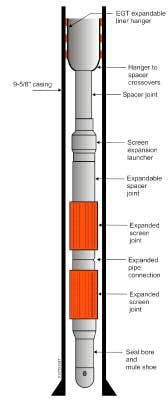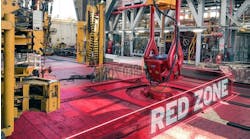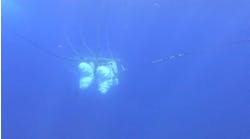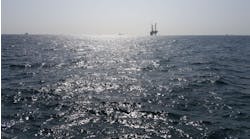Size of retrievable ML with fullbore capacity continues to shrink
The first 5 1/2-in. (139.7mm) retrievable multilateral system (RMLS) was introduced recently by Halliburton Energy Services. The two technology advancement for multilaterals (TAML) level 4 RMLS window installations are said to optimize reservoir management, improve productivity, and increase reservoir drainage. Apparently the smallest in the world, this level 4-system installation advances multilateral (MLT) capabilities to another operating environment.
Level 4 junctions were created by cementing both the main and lateral wellbores, ensuring full mechanical integrity, hydraulic isolation, and an effective barrier against sand production. Throughout the life of the well, the main or lateral wellbores can be selectively produced or isolated. The RMLS junctions were constructed with a pre-milled window joint containing an aperture of known geometry and were run as an integral part of the casing string.
For the multilateral wells, a 12 1/4-in. surface hole was drilled and surface casing was set at 141 meters measured depth (MD). The 7 7/8-in. mainbore was then drilled to 1,252 meters MD, at an inclination of 90.1 degrees, where 5 1/2-in. production casing was set. The casing string consisted of a slotted liner, an external casing packer, a stage tool, and an RMLS window joint. The window joint incorporated a patented latch coupling, which provides precise axial and radial alignment to the aperture while still maintaining fullbore access to the wellbore below. The window joint was set at 82 degrees of inclination and then stage cemented for isolation.
The drilling whipstock was then positioned within the window joint and the lateral was drilled to 1,238 meters MD and 87.1 degrees of inclination. The lateral liner was run and stage cemented using the external casing packer and stage equipment. A washover operation was then conducted, retrieving the drilling whipstock and lateral remnant, and giving fullbore access to both main and lateral wellbores.
Installing multilateral wells is driven by economics. Reducing the number of wells required to exploit the reservoir can eliminate a substantial portion of uphole and surface facility costs for an operator. It is now possible to have multilaterals in even the smallest conventional hole sizes, greatly expanding potential applications and markets.
Abrasive system cuts all casing profiles
An abrasive cutting system capable of severing multiple casing strings simultaneously (Sabre) has been introduced by the UWG Group, which is engaged in the development of abandonment technologies. The system provides flexible cutting technology without the need for a rig. The developers say that, for the first time, all casings in a typical wellbore, regardless of casing loading, eccentricity, and type of fluid in the annuli, can be severed.
The system eliminates explosives, while being safe to use within potentially explosive atmospheres. The system can be operated from a platform or diving support vessel (DSV), another source of cost-savings, compared to traditional rig severance. As part of a recent decommissioning project in the North Sea, the system severed all casing strings in a single pass, three meters below the mudline.
With a high level of sensitivity, the system also allows the cutting of internal casings, without damaging the external casings or wellheads. It can sever casing strings of 9 5/8 in., 13 3/8 in., 20 in., and 30 in. diameters with developments underway to allow severance of 7 in. inner casing strings. In addition, the developers claim it can be used for the majority of subsea severance requirements such as pile, template, and member severance, plus available as a 10,000 psi or 15,000 psi system.
First expandable liner hanger in field trials
Well schematic depicting the first installation of this expandable liner hanger system and screen completion system.
The world's first expandable liner hanger (ELH) system was deployed in a field trial well, operated by Shell E&P. Enventure Global Technology, the developer, installed the 7-5/8 in. ELH, which was run in 9-5/8 in., 53.5 ppf casing and 9.5 ppg water-based mud in the Hinojosa 8 well. The ELH provided hanging capability for the second expandable system tested in this trial, a PoroFlex expandable screen completion system. The 160-ft expansion consisted of three joints of screen and one joint of blank spacer pipe, in which the 5.375-in. run-in outside diameter (OD) was expanded to an OD of 6.125-in. Expansion pressure for the screen and spacer pipe was in the range of 3,600-4,200 psi, as planned.
Once the 7-5/8 in. expandable liner hanger system was run and expanded, the liner lap was pressure-tested to 3,800 psi for 45 minutes. Screen and spacer pipe expansion of the system was confirmed with post-expansion logs. The ELH system combines the functional requirements of a mechanical liner hanger and a liner-top packer, eliminating installation complexity and the need for costly liner-top squeezes. The integral one-piece design of the ELH provides a slimmer hanger profile during cementing and minimizes potential leak paths for the life of the hanger.
The combination of metal-to-metal and elastomer-to-metal contacts created during expansion of the liner is claimed by the developer to produce a robust reliable seal with a high load capacity. ELH field results have produced annular sealing capabilities of 5,000 psi differential with gas, and test-well sealing capacities at 300 degrees F of 7,000 psi burst/4,000 psi collapse, as well as a load-carrying capacity of 425,000 lb. The design incorporates several tiers of contingency to mitigate installation risk, as well as production flexibility to add a polished-bore receptacle (PBR).
The expandable screen completion system provides a larger ID than conventional screens, which:
- Reduces the pressure drop along the producing interval
- Provides direct support to the open hole, thus minimizing sand screen plugging as a result of formation collapse
- Provides higher burst and collapse ratings with its perforated solid base pipe
- Reduces plugging and subsequent erosion damage, which leads to improved, long-term sand control
- Eliminates the need for gravel packing.
The expandable threaded connections allow standard make-up, and either weight-down or hydraulic expansion is available using the same proprietary expansion tool.
A second ELH system was installed during a five-day period. The 9-5/8 in. 53.5 X 7-5/8 in. ELH/ packer system was run in the 9-5/8 in. 53.5 ppf casing of the McLean Heirs #7 well using 16.1 ppg oil-base mud. The ELH provided the hanging capacity for 3,578 ft of 7-5/8 in. 29.7 ppf liner and the sealing mechanism for the liner lap. The liner hung below the expandable liner hanger/packer system was all standard equipment: casing, connections, and float equipment. The top of the expandable liner hanger was at a depth of 8,212 ft, while the bottom of the liner was set at 11,800 ft in the near-vertical wellbore. The liner hanger was cemented prior to the expansion of the hanger joint. Once run and expanded, the liner lap was pressure-tested to 1,900 psi for 30 minutes, per operator and regulatory requirements. To date, Enventure has installed 36 solid expandable tubular systems, and expanded a total of 20,767 ft of tubulars and 590 connections.




